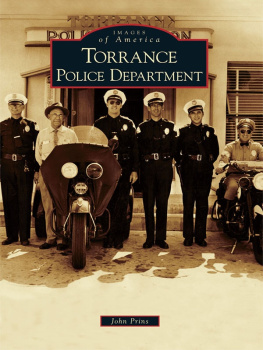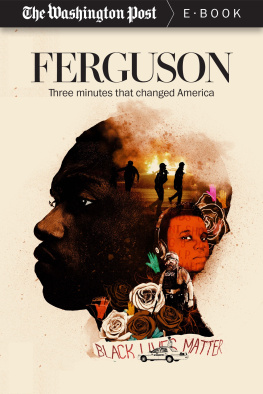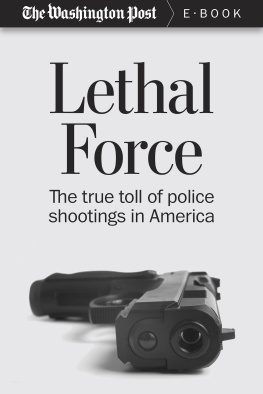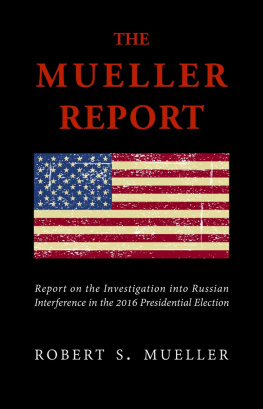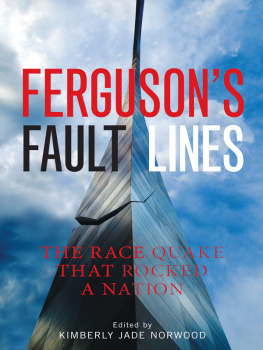Theodore M. Shaw, former director-counsel and president of the NAACP Legal Defense and Educational Fund, is the Julius L. Chambers Distinguished Professor of Law and Director of the Center for Civil Rights at the University of North Carolina School of Law at Chapel Hill, where he lives.

Introduction 2015 by Theodore M. Shaw
All rights reserved.
No part of this book may be reproduced, in any form, without written permission from the publisher.
Requests for permission to reproduce selections from this book should be mailed to:
Permissions Department, The New Press, 120 Wall Street, 31st floor, New York, NY 10005.
Published in the United States by The New Press, New York, 2015.
Distributed by Perseus Distribution
LIBRARY OF CONGRESS CATALOGING-IN-PUBLICATION DATA
The Ferguson report : Department of Justice investigation of the Ferguson Police Department / United States Department of Justice, Civil Rights Division; introduction by Theodore M. Shaw.
pages cm
ISBN 978-1-62097-165-9 (e-book) 1. Ferguson (Mo.). Police Department. 2. Discrimination in criminal justice administrationFergusonMissouri. 3. Police-community relationsMissouriFerguson. 4. PoliceComplaints againstMissouriFerguson. I. Shaw, Theodore M. II. United States. Department of Justice.
HV8148.F47F47 2015
364.1'3230977865dc23
2015015187
The New Press publishes books that promote and enrich public discussion and understanding of the issues vital to our democracy and to a more equitable world. These books are made possible by the enthusiasm of our readers; the support of a committed group of donors, large and small; the collaboration of our many partners in the independent media and the not-for-profit sector; booksellers, who often hand-sell New Press books; librarians; and above all by our authors.
www.thenewpress.com
Book design and composition by Bookbright Media
Printed in the United States of America
10 9 8 7 6 5 4 3 2 1
CONTENTS
by Theodore M. Shaw
THEODORE M. SHAW
WHILE MOST FATAL SHOOTINGS OF UNARMED BLACK PEOPLE DO NOT lead to uprisings, riots, or rebellions, for decades now, almost every major urban uprising or race riot in the United States has begun with an interaction, often fatal, between a black man and the police. The Harlem race riot of 1964, the 1965 Watts race riot, the 1967 Newark race riot, the 1980 Liberty City, Florida, race riot, the 1992 Rodney King riot in Los Angeles, the 1996 St. Petersburg, Florida, race riot, the 2001 Cincinnati race riot, and the protests following the killing of Oscar Grant in Oakland in 2009 all started the same way. As we prepared to go to press, with the death of Freddie Gray, Baltimore became yet another city that has erupted in violence following allegations of excessive force against black men by law enforcement.
In August 2014 a policeman in the St. Louis suburb of Ferguson, Missouri, shot and killed an eighteen-year-old, unarmed black man. As conflicting versions of the event circulated through the majority black town, tensions escalated. Aided by social media and amplified by the twenty-four hour news cycle, news from Ferguson flashed across the nation and around the world. In the hours, days, weeks, and months that followed the death of Michael Brown at the hands of Officer Darren Wilson, protest ensued, mostly peaceful but some violent enough to have become known as the Ferguson riots.
Ferguson did not happen in a vacuum. Police killings of unarmed individuals are, unfortunately, not uncommon. While the facts of each case are different, there is a numbing familiarity when an unarmed black boy, teenager, or man is killed by a police officer. A well-worn script often unfolds in the aftermath of each death: The police officer recounts a threat to his life, which allegedly includes a weapon. The dead black man is dehumanized and demonized through the release of any record of past wrongdoing in an attempt to implant the worthy-of-death notion in the publics mind. In most instances, state and local authorities do not bring charges against the officer. In the rare circumstance when there is an indictment, the officer is, more often than not, cleared of wrongdoing. In many cases the family of the decedent and community activists seek federal review and prosecution, usually without success. For the families of the unarmed dead, there is rarely any semblance of justice.
Many black people are bone weary and cynical about a broken criminal justice system that is quick to incarcerate individuals from their communities, even while it countenances the harassment and even the killing of unarmed individuals by law enforcement. A black woman, Marissa Alexander of Jacksonville, Florida, unsuccessfully invoked Floridas stand your ground law and was sentenced to twenty years in prison for firing a warning shot, allegedly in defense against an abusive husband; George Zimmerman, a neighborhood watch volunteer, successfully invoked Floridas stand your ground law to allow him to kill unarmed, seventeen-year-old Trayvon Martin with impunity.
The survivors of the unarmed and innocent dead include a bereaved network of mothers and fathers, sisters and brothers, widows and girlfriends, widowers and boyfriends, and children. Some have become involuntary activists who, long before Michael Brown died in Ferguson, ceaselessly voiced anguish over the deaths of their unarmed loved ones and pursued a seemingly futile quest for justice. Others live with a dull ache and a hole in their spirits and in their hearts, dug by the despair that is the child of hopelessness.
While the Justice Department has investigated excessive force in a number of police departments, what may distinguish Ferguson is the fact that on March 4, 2015, the United States Department of Justice, Civil Rights Division, issued a 102-page report on policing in Ferguson In summary, the Ferguson Report reveals a pattern or practice of unlawful conduct within the Ferguson Police Department that violates the First, Fourth, and Fourteenth amendments to the United States Constitution, and federal statutory law. Over the years there have been a number of investigations and reports on the causes of and events surrounding racial violence in American communities; the Ferguson report stands out both for its comprehensive detail and as a twenty-first century reminder that we have not left this kind of unrest in our rearview mirror.
The events in Ferguson in the summer of 2014 were bigger than Michael Brown and Darren Wilson. And the Ferguson protests ignited a multiracial campaign, if not a movement, captured in the refrain Black Lives Matter, reminding us of a long, sordid history of violence by private actors and law enforcement against African Americans and the devaluation of black lives, stretching from slavery and reconstruction to the present.
In 1944 the Swedish sociologist Gunnar Myrdal, in his classic study of race in America, An American Dilemma, wrote that he was convinced that the Southern police system... represents a crucial and strategic factor in race relations. Seventy years later, these observations remain sadly true, even in the wake of the Ferguson report. Mere months after the reports initial release the nation was bombarded by the video of the shooting death of Walter Scott in North Charleston, South Carolina, shot in the back by a policeman after a traffic stop.
But going beyond these extreme cases, and citing sociologist Arthur Raper, Myrdal further identified a more insidious force at work: the dynamics of the fee system, in which all the minor court officials, and in some instances the prosecuting attorneys get their pay out of fines.
Next page

